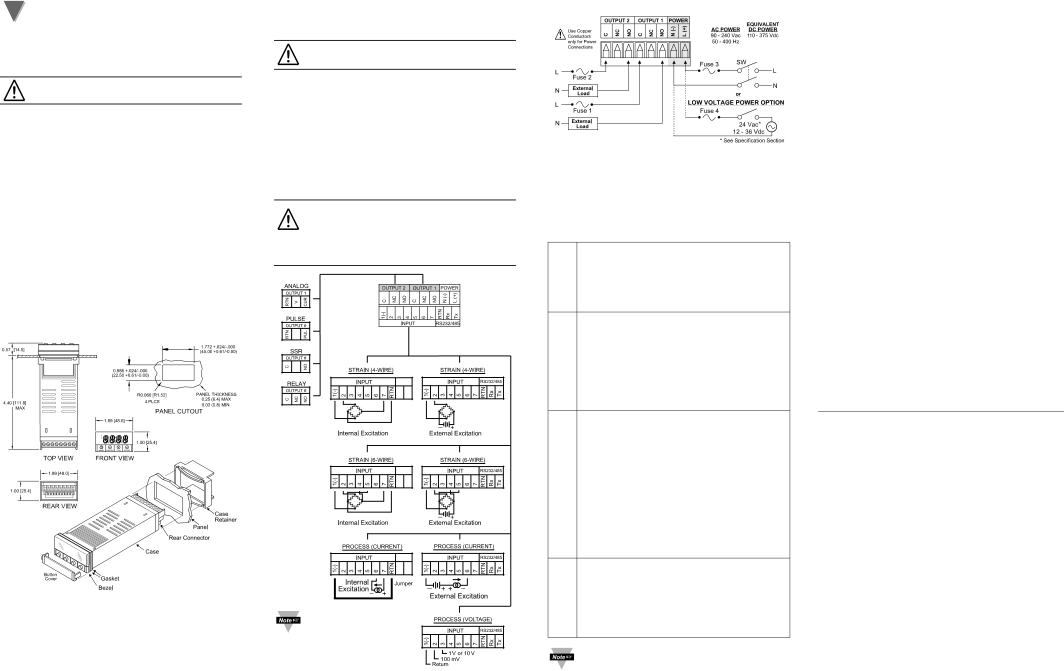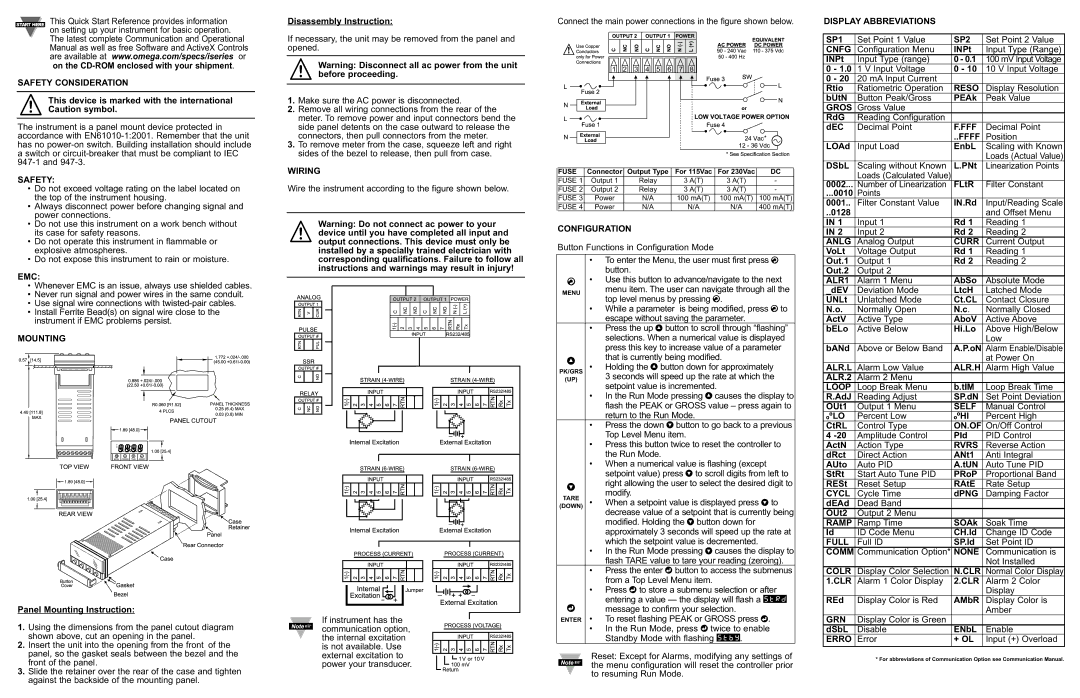
START HERE This Quick Start Reference provides information on setting up your instrument for basic operation.
The latest complete Communication and Operational Manual as well as free Software and ActiveX Controls are available at www.omega.com/specs/iseries or
on the
SAFETY CONSIDERATION
This device is marked with the international Caution symbol.
The instrument is a panel mount device protected in accordance with
SAFETY:
•Do not exceed voltage rating on the label located on the top of the instrument housing.
•Always disconnect power before changing signal and power connections.
•Do not use this instrument on a work bench without its case for safety reasons.
•Do not operate this instrument in flammable or explosive atmospheres.
•Do not expose this instrument to rain or moisture.
EMC:
•Whenever EMC is an issue, always use shielded cables.
•Never run signal and power wires in the same conduit.
•Use signal wire connections with
•Install Ferrite Bead(s) on signal wire close to the instrument if EMC problems persist.
MOUNTING
Panel Mounting Instruction:
1.Using the dimensions from the panel cutout diagram shown above, cut an opening in the panel.
2.Insert the unit into the opening from the front of the panel, so the gasket seals between the bezel and the front of the panel.
3.Slide the retainer over the rear of the case and tighten against the backside of the mounting panel.
Disassembly Instruction:
If necessary, the unit may be removed from the panel and opened.
Warning: Disconnect all ac power from the unit before proceeding.
1.Make sure the AC power is disconnected.
2.Remove all wiring connections from the rear of the meter. To remove power and input connectors bend the side panel detents on the case outward to release the connectors, then pull connectors from the meter.
3.To remove meter from the case, squeeze left and right sides of the bezel to release, then pull from case.
WIRING
Wire the instrument according to the figure shown below.
Warning: Do not connect ac power to your device until you have completed all input and output connections. This device must only be installed by a specially trained electrician with corresponding qualifications. Failure to follow all instructions and warnings may result in injury!
If instrument has the communication option, the internal excitation is not available. Use external excitation to power your transducer.
Connect the main power connections in the figure shown below.
1 2 3 4 5 6 7 8
FUSE | Connector | Output Type | For 115Vac | For 230Vac | DC |
FUSE 1 | Output 1 | Relay | 3 A(T) | 3 A(T) | - |
FUSE 2 | Output 2 | Relay | 3 A(T) | 3 A(T) | - |
FUSE 3 | Power | N/A | 100 mA(T) | 100 mA(T) | 100 mA(T) |
FUSE 4 | Power | N/A | N/A | N/A | 400 mA(T) |
CONFIGURATION
Button Functions in Configuration Mode
•To enter the Menu, the user must first press a
button.
a• Use this button to advance/navigate to the next
MENU | menu item. The user can navigate through all the | |
top level menus by pressing a. | ||
|
•While a parameter is being modified, press a to escape without saving the parameter.
•Press the up b button to scroll through “flashing” selections. When a numerical value is displayed press this key to increase value of a parameter
bthat is currently being modified.
PK/GRS • | Holding the b button down for approximately |
(UP) | 3 seconds will speed up the rate at which the |
| setpoint value is incremented. |
•In the Run Mode pressing b causes the display to flash the PEAK or GROSS value – press again to return to the Run Mode.
•Press the down c button to go back to a previous Top Level Menu item.
•Press this button twice to reset the controller to the Run Mode.
•When a numerical value is flashing (except setpoint value) press c to scroll digits from left to
cright allowing the user to select the desired digit to
TARE | modify. | |
• When a setpoint value is displayed press c to | ||
(DOWN) | ||
| decrease value of a setpoint that is currently being | |
| modified. Holding the c button down for | |
| approximately 3 seconds will speed up the rate at | |
| which the setpoint value is decremented. |
•In the Run Mode pressing c causes the display to flash TARE value to tare your reading (zeroing).
•Press the enter d button to access the submenus from a Top Level Menu item.
•Press d to store a submenu selection or after entering a value — the display will flash a STRD
dmessage to confirm your selection.
ENTER • To reset flashing PEAK or GROSS press d.
•In the Run Mode, press d twice to enable Standby Mode with flashing STBY.
Reset: Except for Alarms, modifying any settings of the menu configuration will reset the controller prior to resuming Run Mode.
DISPLAY ABBREVIATIONS
SP1 | Set Point 1 Value | SP2 | Set Point 2 Value | |
CNFG | Configuration Menu | INPt | Input Type (Range) | |
INPt | Input Type (range) | 0 - 0.1 | 100 mV Input Voltage | |
0 - 1.0 | 1 V Input Voltage | 0 - 10 | 10 V Input Voltage | |
0 - 20 | 20 mA Input Current |
|
| |
Rtio | Ratiometric Operation | RESO | Display Resolution | |
bUtN | Button Peak/Gross | PEAk | Peak Value | |
GROS | Gross Value |
|
| |
RdG | Reading Configuration |
|
| |
dEC | Decimal Point | F.FFF | Decimal Point | |
|
| ..FFFF | Position | |
LOAd | Input Load | EnbL | Scaling with Known | |
|
|
| Loads (Actual Value) | |
DSbL | Scaling without Known | L.PNt | Linearization Points | |
| Loads (Calculated Value) |
|
| |
0002... | Number of Linearization | FLtR | Filter Constant | |
...0010 | Points |
|
| |
0001.. | Filter Constant Value | IN.Rd | Input/Reading Scale | |
..0128 |
|
| and Offset Menu | |
IN 1 | Input 1 | Rd 1 | Reading 1 | |
IN 2 | Input 2 | Rd 2 | Reading 2 | |
ANLG | Analog Output | CURR | Current Output | |
VoLt | Voltage Output | Rd 1 | Reading 1 | |
Out.1 | Output 1 | Rd 2 | Reading 2 | |
Out.2 | Output 2 |
|
| |
ALR1 | Alarm 1 Menu | AbSo | Absolute Mode | |
_dEV | Deviation Mode | LtcH | Latched Mode | |
UNLt | Unlatched Mode | Ct.CL | Contact Closure | |
N.o. | Normally Open | N.c. | Normally Closed | |
ActV | Active Type | AboV | Active Above | |
bELo | Active Below | Hi.Lo | Above High/Below | |
|
|
| Low | |
bANd | Above or Below Band | A.P.oN | Alarm Enable/Disable | |
|
|
| at Power On | |
ALR.L | Alarm Low Value | ALR.H | Alarm High Value | |
ALR.2 | Alarm 2 Menu |
|
| |
LOOP | Loop Break Menu | b.tIM | Loop Break Time | |
R.AdJ | Reading Adjust | SP.dN | Set Point Deviation | |
OUt1 | Output 1 Menu | SELF | Manual Control | |
ººLO | Percent Low | ººHI | Percent High | |
Control Type | On/Off Control | |||
CtRL | ON.OF | |||
4 | Amplitude Control | PId | PID Control | |
ActN | Action Type | RVRS | Reverse Action | |
dRct | Direct Action | ANt1 | Anti Integral | |
AUto | Auto PID | A.tUN | Auto Tune PID | |
StRt | Start Auto Tune PID | PRoP | Proportional Band | |
RESt | Reset Setup | RAtE | Rate Setup | |
CYCL | Cycle Time | dPNG | Damping Factor | |
dEAd | Dead Band |
|
| |
OUt2 | Output 2 Menu |
|
| |
RAMP | Ramp Time | SOAk | Soak Time | |
Id | ID Code Menu | CH.Id | Change ID Code | |
FULL | Full ID | SP.Id | Set Point ID | |
COMM | Communication Option* | NONE | Communication is | |
|
|
| Not Installed | |
COLR | Display Color Selection | N.CLR | Normal Color Display | |
1.CLR | Alarm 1 Color Display | 2.CLR | Alarm 2 Color | |
|
|
| Display | |
REd | Display Color is Red | AMbR | Display Color is | |
|
|
| Amber | |
GRN | Display Color is Green |
|
| |
dSbL | Disable | ENbL | Enable | |
ERRO | Error | + OL | Input (+) Overload | |
|
|
|
|
* For abbreviations of Communication Option see Communication Manual.
